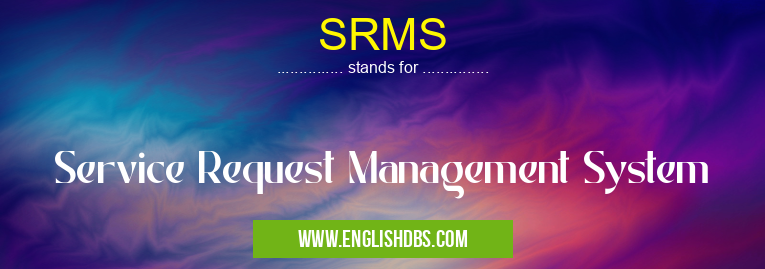What does SRMS mean in MANAGEMENT
SRMS (Service Request Management System) is a comprehensive software solution designed to streamline and enhance the management of service requests within organizations. It provides a central platform for capturing, tracking, and resolving requests from various channels, ensuring efficient and timely service delivery.

SRMS meaning in Management in Business
SRMS mostly used in an acronym Management in Category Business that means Service Request Management System
Shorthand: SRMS,
Full Form: Service Request Management System
For more information of "Service Request Management System", see the section below.
» Business » Management
Key Features of SRMS
- Centralized Request Management: SRMS consolidates service requests from multiple sources, including phone calls, emails, web portals, and mobile applications, into a single repository.
- Automated Request Routing: Requests are automatically routed to the appropriate team or individual based on predefined criteria, ensuring prompt attention and resolution.
- SLA (Service Level Agreement) Tracking: SRMS monitors and enforces SLAs, alerting managers when response or resolution times are exceeded.
- Knowledge Base Integration: It seamlessly integrates with knowledge bases, allowing technicians to access relevant information and provide prompt solutions.
- Collaboration and Communication: SRMS fosters collaboration among team members and customers, facilitating transparent communication and efficient issue resolution.
- Reporting and Analytics: It provides comprehensive reports and analytics, helping organizations analyze service request trends, identify bottlenecks, and improve service delivery.
Benefits of SRMS
- Improved Customer Satisfaction: By streamlining request management, SRMS reduces response times and improves resolution efficiency, leading to enhanced customer satisfaction.
- Increased Productivity: Automation and efficient routing minimize manual tasks, freeing up resources to focus on complex issues and value-added activities.
- Reduced Operational Costs: Centralized management and automation reduce the need for additional staff, resulting in lower operational expenses.
- Enhanced Service Visibility: A single platform provides a comprehensive view of all service requests, enabling managers to monitor performance and make data-driven decisions.
- Improved Compliance: SRMS helps organizations comply with industry regulations and standards, ensuring adherence to best practices.
Essential Questions and Answers on Service Request Management System in "BUSINESS»MANAGEMENT"
What is a Service Request Management System (SRMS)?
An SRMS is a software solution that automates and streamlines the process of managing service requests. It provides a central platform for users to submit, track, and resolve requests for various services, such as IT support, facilities maintenance, and customer service.
What are the benefits of using an SRMS?
SRMSs offer numerous benefits, including:
- Improved efficiency: Automating the request process saves time and resources.
- Enhanced communication: Centralized platforms facilitate clear communication between requesters and service providers.
- Increased visibility: SRMSs provide managers with real-time visibility into the status of requests, helping them prioritize and allocate resources effectively.
- Improved customer satisfaction: By streamlining the request process and providing timely support, SRMSs enhance customer satisfaction.
What types of organizations can benefit from an SRMS?
SRMSs are suitable for organizations of all sizes and industries, including:
- IT departments
- Facilities management teams
- Customer service organizations
- HR departments
- Manufacturing companies
- Educational institutions
How does an SRMS integrate with other systems?
Many SRMSs offer integration capabilities with other enterprise systems, such as:
- CRM (Customer Relationship Management) systems to manage customer interactions.
- ERP (Enterprise Resource Planning) systems to handle business processes.
- ITSM (IT Service Management) tools to manage IT infrastructure and services.
- Help desk software to provide technical support.
What are the key features to look for in an SRMS?
When selecting an SRMS, consider the following key features:
- Request tracking: Ability to track the status of requests throughout their lifecycle.
- Knowledge base: A repository of information to help users self-resolve common issues.
- Reporting and analytics: Tools for generating reports and analyzing performance metrics.
- Customization: Flexibility to tailor the system to meet specific organizational needs.
- Mobile compatibility: Accessibility from smartphones and tablets.
Final Words: SRMS is a powerful tool that empowers organizations to manage service requests effectively and efficiently. By automating processes, improving communication, and providing valuable insights, it helps organizations deliver exceptional customer service, optimize operations, and achieve business goals.
SRMS also stands for: |
|
| All stands for SRMS |
